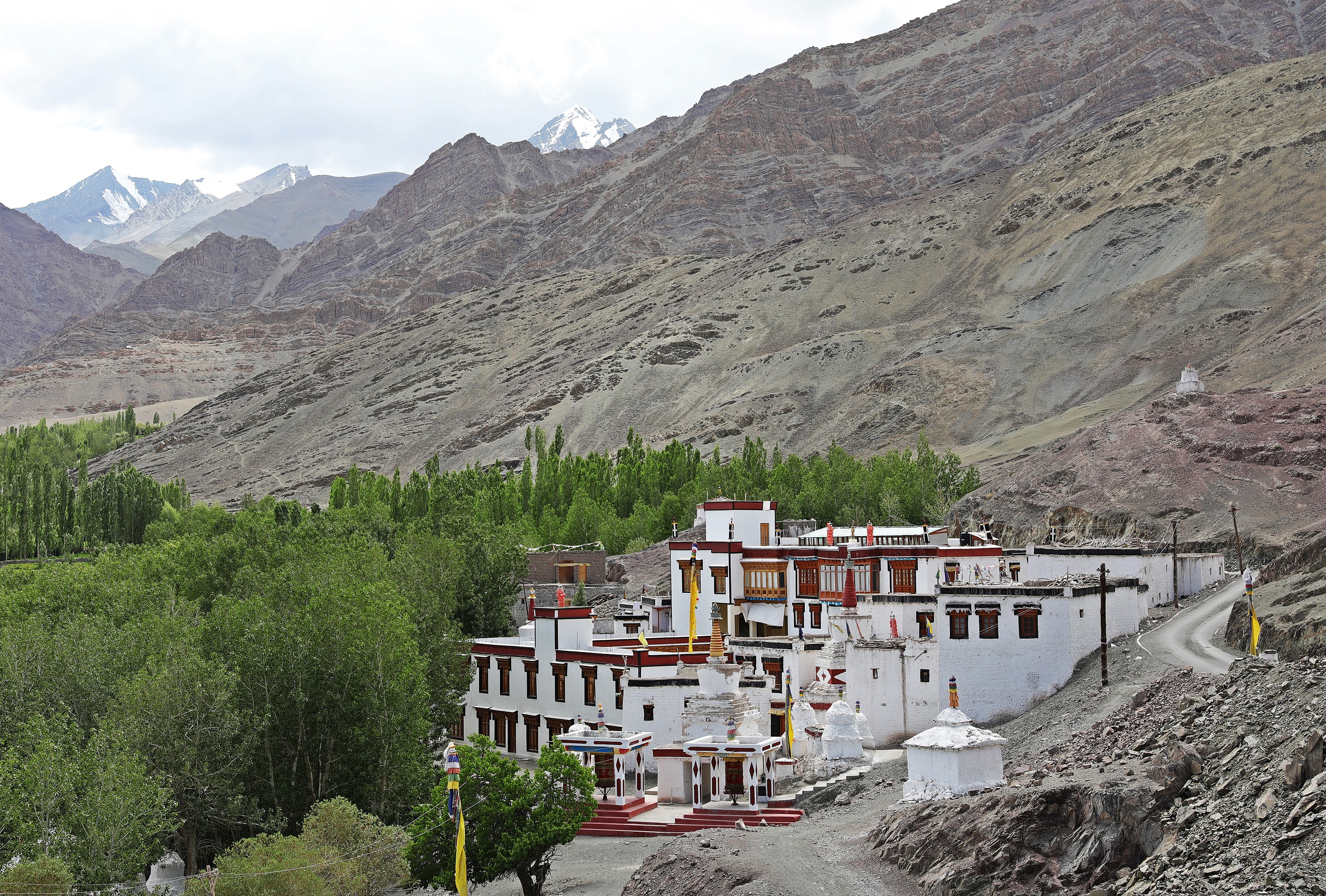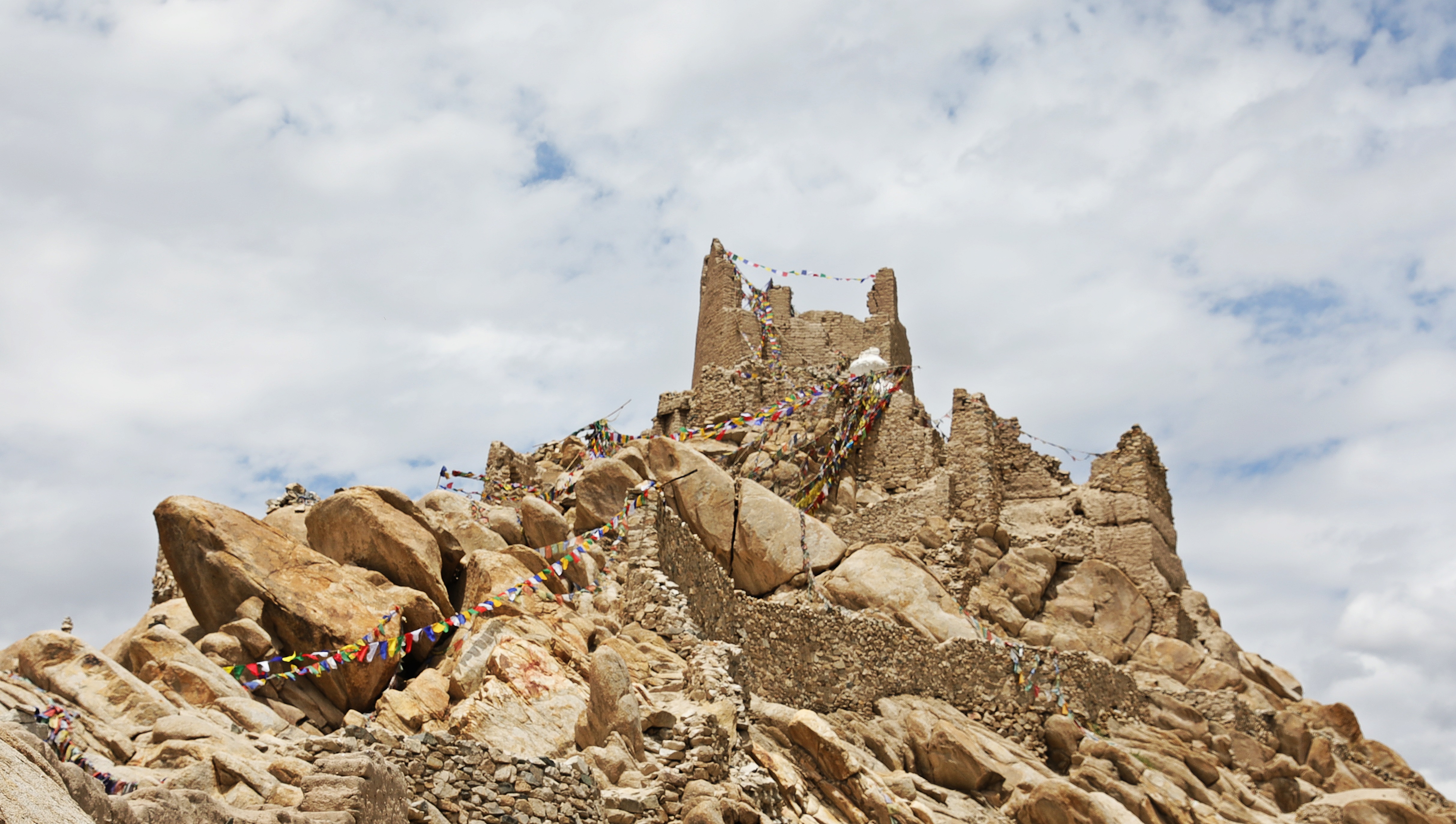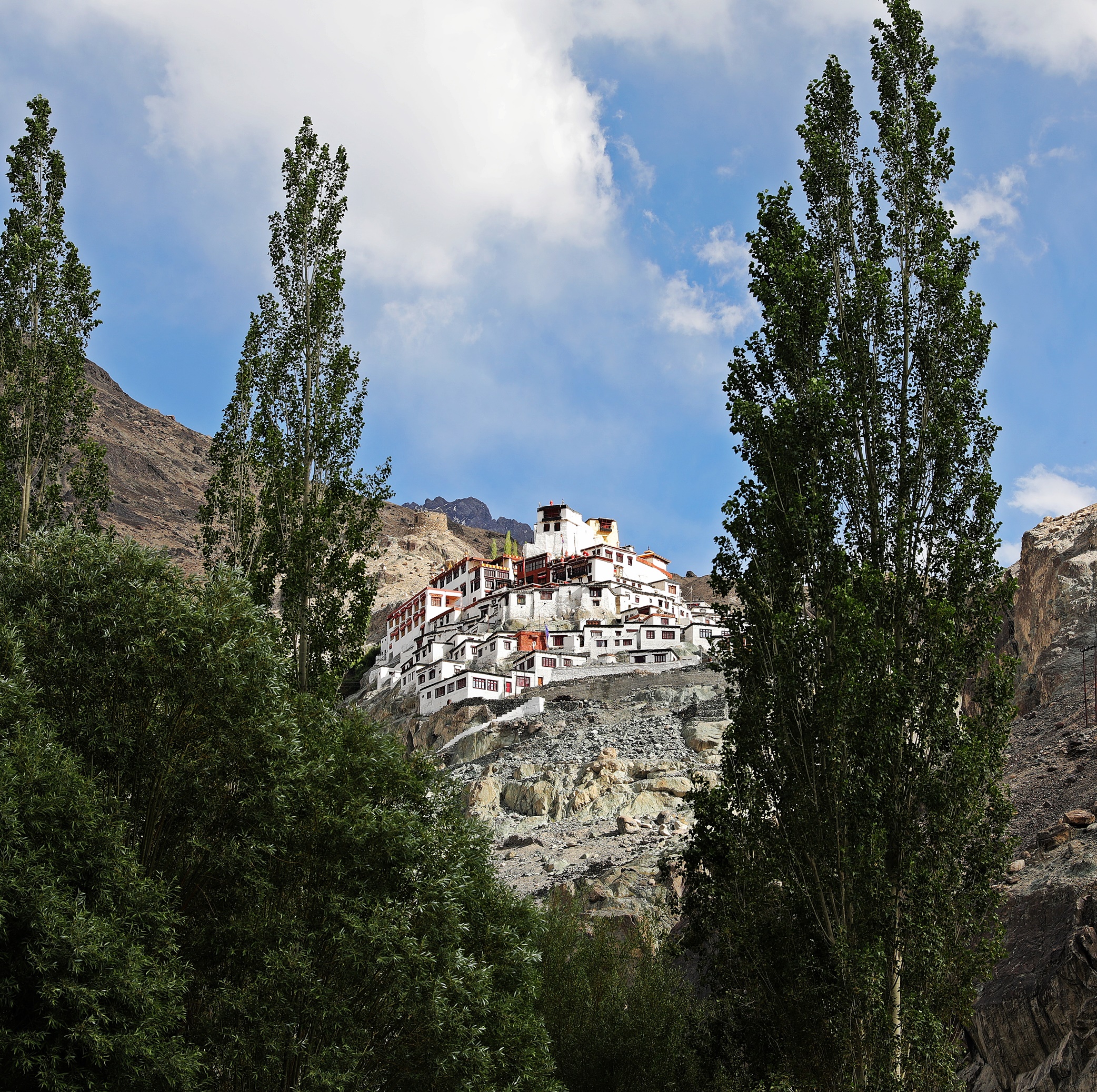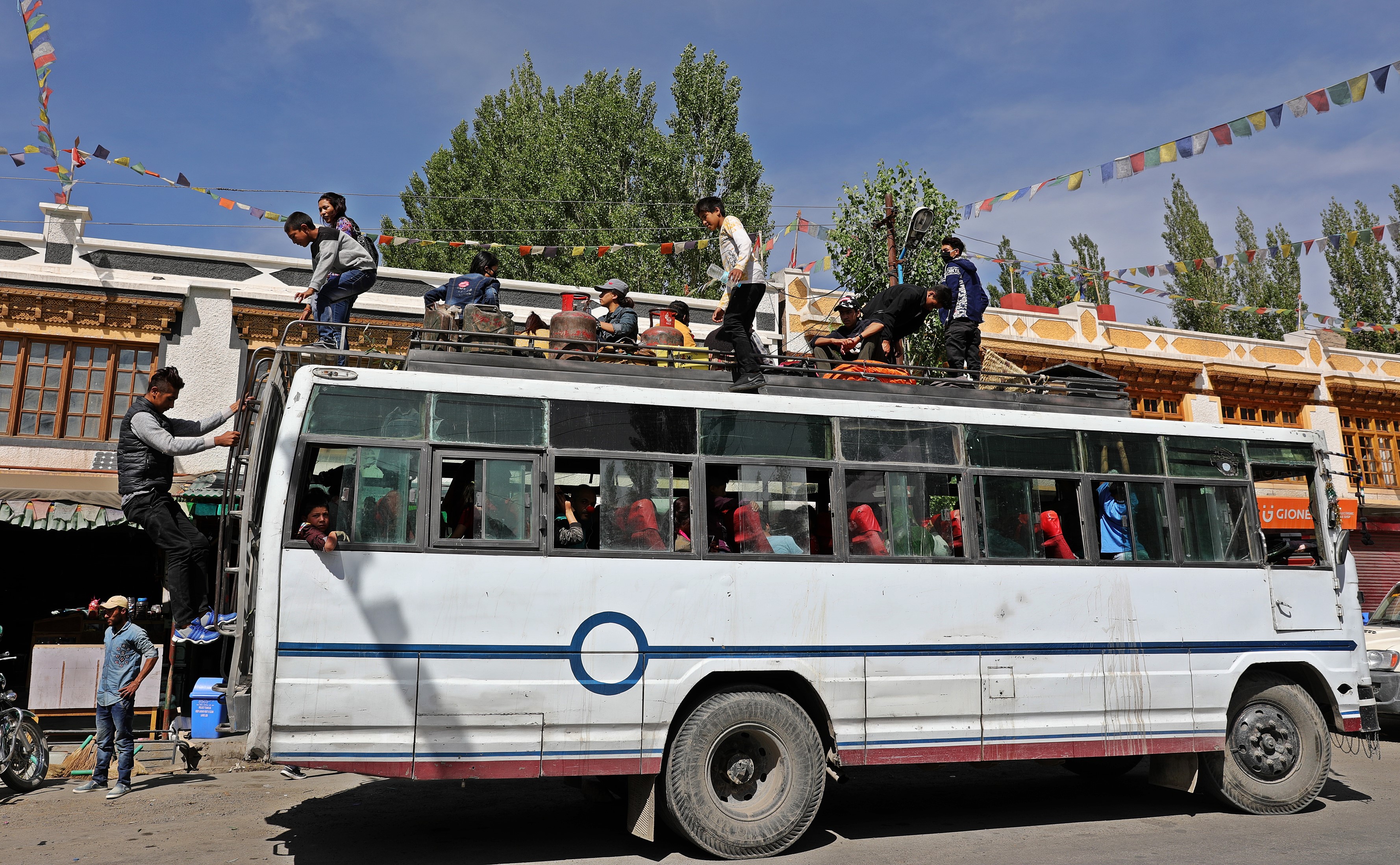Palaces, monasteries and Tibetan culture make Leh and the surrounding area an interesting place to explore. Tibetan Buddhism came to Ladakh in the 17th century and in recent history, many Tibetans fled Tibet to settle in Ladakh. Between the arid landscape and Tibetan architecture, Ladakh feels more like Tibet than India.
Leh is the ‘capital’ of the district of Ladakh in the Indian Himalayas. Set in the Indus River Valley, surrounded by the arid Ladakh and Zanskar Mountain Ranges, Leh has a gorgeous setting. Being located in the mountains, there are many mountain activities available. This makes Leh the tourist hub for Ladakh with many hotels, restaurants and shops.

Zanskar Range seen from the highway

Downtown Leh

Leh as seen from Tsemo Fort
Old Town Leh looks like a Tibetan village with typical flat roofed, compressed-mud buildings lining narrow, meandering streets. On the hill above Old Town is Leh Palace which was built in the 16th century when Ladakh was a kingdom and abandoned in the mid-19th century when the royals lost power. The palace is built in the same style as Tibetan monasteries, but its dull colour makes it less impressive. Above the palace is the white Tsemo Fort and its two red temples also from the 16th century. These structures can be seen from almost anywhere in Leh.

Old Town Leh

Leh Palace seen from Old Town

Leh Palace

Tsemo Fort, Leh

Leh with the palace and fort in the background

Tsemo Fort, Leh
Throughout this devoutly Buddhist town are new and old chortens, mani walls, kanis and prayer wheels.

Nezer Latho shrine for Leh’s guardian deity

Shanti Stupa, Leh

Gomang Chorten, Leh
We went to a traditional Ladaki dance show where men and women dressed in costumes and performed dances from the various regions of Ladakh. The dances were accompanied by traditional instruments. Later that day we happened to see a funeral procession for an important lama. The lamas were in traditional dress and played instruments as they walked through the streets.

Traditional Ladakhi dance

Musicians for the traditional Ladakhi dancers

Traditional Ladakhi dance

Traditional Ladakhi dance

Traditional Ladakhi dance

Funeral procession in Leh
One of the Ladakh Royal’s summer palaces is about 15 km away in the small village of Stok. This palace was built in the early 1800s and is being turned into a hotel. The Stok Gompa (monastery) can be seen near-by under the snow-capped peak of Stok Kangri (6121m).

Stok Palace

Stok Gompa with Stock Kangri Peak above
Further east of Stok is the village of Shey with its ancient fortress ruins from its time as the capital of Ladakh. Below these ruins is the summer palace, Naropa Palace, from the 17th century. Inside the palace’s temple is a 7 m tall bronze Buddha with a smirking smile.

Shey Palace with fortress ruins behind

Shey fortress ruins

Buddha statue in Shey Palace

Dozens of chortens below Shey Palace
Ladakh has many Buddhist gompas, possibly more than are in all of Tibet. We visited several gompas in the Indus River Valley southeast of Leh. All were built in the 16th century in the Tibetan style. Thiksey Gompa, is one of this area’s largest and most impressive monasteries. The well-kept white monastery buildings and colourful temples are spread out on a steep hill above green barley and buckwheat fields. The Dalai Lama was visiting the monastery on the same day but left about 5 minutes before we arrived. The streets in front of the monastery were filled with pilgrims carrying flowers and flags to welcome him.

Tiksey Gompa

Tiksey Gompa

Colourful courtyard in Tiksey Gompa

Temple in Thiksey Gompa
We also stopped at Stakna and Thekchhok Gompas. Stakna is a small gompa set on a hill along the Indus river. Thekchhok Gompa is larger with a number of white-washed buildings crowded on a rocky hillock above small farms and green barley and buckwheat fields.

Stakna Gompa

Stakna Gompa

Thekchhok Gompa

Thekchhok Gompa

View of barley and buckwheat fields from Thekchhok Gompa

Thekchhok Gompa, Chemrey

Old prayer wheels in Thekchhok Gompa
In northern Ladakh, the Nubra and Shyok River valleys are dotted with small villages in the few areas of green oases amidst the arid landscape. The drive to this area involves crossing Khardung La, which at 5602m is the highest motorable pass in the world. From the pass we could see the high mountains of the Karakoram Range in Pakistan.

Karakoram Range seen from Khardung La

Village of Khardong, Nubra Valley

Nubra Valley
In the Nubra Valley is the Buddhist town of Disket with a large 17th century Gompa. The white monastery buildings are set on a rocky outcrop, nestled between two vertical cliffs. It’s a dramatic scene to see the temples and other monastery buildings squeezed together on this unlikely spot. Across from the monastery is a large, golden statue of Future Buddha. Below the gompa, the town has many old chortens surrounding a long mani wall.

Diskit Gompa

Diskit Gompa set between two cliffs

Diskit Gompa

View from Diskit Gompa

Diskit Gompa

Statue of Future Buddha, DIskit

Chortens in Diskit with Gompa in the background
We followed beside the wild and fast-running Shyok River to the isolated communities of Turtuk and Bogdang. Turtuk was a part of Pakistan until the 1970s and is only 7 km from the Pakistan border. The people in these towns are Balti Muslim. There are only 6000 Balti speakers in all of India, some are here and others are in the Zanskar valley south of Leh. When we were visiting, the villagers were harvesting barley. Large piles of cut barley lined the sides of the highway as we passed through Bogdang. In Turtuk, we saw the villagers carrying huge bundles on their backs and taking to the de-husker machines. Upper Turtuk is an interesting place with its maze of narrow sidewalks lined with medieval looking homes built of stone. Attached to the homes were small animal paddocks enclosed by stone fences. Also in season were apricots. There were many apricot trees in public areas so we took full advantage and ate at least 1 kilo of the delicious fruit.

Shyok River Valley

Barley fields in Turtuk

Barley fields above the Shyok River, Turtuk

De-husking barley, Turtuk

Turtuk villager carrying a load of barley

Laundry day in Turtuk

Upper Turtuk village
Driving in Ladakh
Over the past 10 months we have been in many buses, taxis, minibuses etc, but none of these compare to the rides we’ve had in our short time in Ladakh and Kashmir. We’ve been in vehicles that pick up hitch-hikers who then ride on the foot runners and even roofs of jeeps and buses! Our first bad experience was on a 10-12 hour drive from Srinagar to Leh. The highway took us over high, steep, zigzagging passes. The problems on this drive was that our jeep did not have 1st or 2nd gear and had a very hard time making it up these passes. On these roads the cars don’t travel at 110km/hr, they drive 30 – 40km/hr. A few times our driver couldn’t make the slow climb in 3rd gear so had to reverse down the hill to flatter ground so that he could pick up enough speed to try again. The 10-12hr drive took 14 hours! On a jeep ride to Zanskar, the driver snuck a bottle of moonshine into the car. He stared weaving over the road trying to avoid non-existent potholes while taking swigs from his ‘water’ bottle. We finally figured out what was happening after he had drank almost 300ml of pure moonshine. Luckily we only had 25km more to reach our destination, but he drove so slow in his inebriated state that it took 2 hours! At that point we were in the middle of nowhere and had no other options but to stay in his jeep. On our drive back from remote Zanskar (story in an upcoming blog) our jeep had a flat tire. Unfortunately, the spare tire was also flat. The driver ended up borrowing a spare from another vehicle! Because this area is so remote, we drove 6 hours on the spare until he was able to get his tire repaired. Luckily neither vehicle had another flat.
Buses in Ladakh are old 1960 models that are very worn out. The drivers cram as many people inside the non-air-conditioned buses as possible. A 35-seat bus will often have as many as 75 passengers, and that’s not including the riders on the roof!
Our latest experience was the worst. On a 20 1/2 hour, 470km drive from Leh to Manali there were many scary moments. Within the first 1 1/2 hours of this long journey the bus started to have engine problems. The driver stopped at least 3 times to do a make-shift repair. Richard thinks he saw them using bubble gum! Eventually though, it seemed to work, at least for the rest of our drive. Most of the ride’s excitement was caused by the road itself. There are 4 high passes to cross at 4900m or higher. The biggest scare came when we encountered a convoy of on-coming army trucks on the first pass. Much of these steep climbs are only wide enough for one vehicle at a time with the rock face on one side and a 500m high, vertical cliff on the other. When meeting another vehicle someone has to move to a wider part of the road. This time it was our turn, so our driver reversed the bus to get as close to the sheer cliff as possible. He only stopped when the entire back half of the bus began screaming because the back wheel was inches away from the loose gravel drop-off! Everyone was terrified. Going up these steep passes involves many tight switchbacks, some of them were not wide enough for our bus to complete so he had to back up to attempt again. After the last episode, we kept a close eye on how far he was backing up. The final pass of the drive was not very high, but since there are many landslides on it during monsoon season, there is a lot rock and debris making a rough ride. It was about 15 hours since we let Leh, so it was pitch black and half way up the pass, we were in a dense fog resulting in very low visibility. As times the road was so rough, we thought the driver missed a turn and we were off-roading! Combine all of this with the same narrow lanes and the drive was treacherous. We really thought we may die in a car accident in India. Let’s hope the roads get better.

Traveling Indian style
Coming up next: Ladakh’s Incredible Zanskar and Hidden Valleys
For extra pics from this trip go to Gallery/Northern India. For extra pictures from other blogs go to Gallery at monkeystale.ca
To read about more of our adventures go to Destinations.
If you like what you read, please share it using the links below.
wouw.. what an adventure and interesting story you had. Gosh…I would be very scared myself if the driver drinking alcohol while driving. tsk….tsk…scary.
and the bus with engine problem and fix with bubble gumm.. ha.ha..it make me laugh.. I could not believe it.
My husband wants to go to India but I am reluctant about it. ha..ha.. maybe one day we will go there but not now.
LikeLiked by 1 person
hopefully the driving stories will get less scary, and you’ll be inspired to go!
LikeLike
10-12 hours Srinigar to Leh?! Wow, they must have really upgraded that road, since it took us two days. And bus ride Leh to Manali? Did you have to pass by Kargil? And is there now a road from Zanskar to Manali?
Great photos!
LikeLiked by 2 people
Yes, supposedly the road is a lot better, but still pretty poor from Srinagar to Kargil. Leh to Manali goes south east of Leh so not to Kargil. It’s an awful road. To get from Zanskar to Manali you have to trek about 60km from Purne (near Phugtal) to Darcha and then catch a bus. We didn’t realize it early enough so would have done this if we knew. Thanks for reading!
LikeLike
OK, note to self… walk!
With regards to difficult drives, my experience comes mostly in Central Asia, where cars are rubbish and roads play a significant part in making them thusly, but I’ve never had anything but great drivers and always felt safe-ish… Never, ever seen anyone drinking whilst driving. Drivers might’ve been Muslim, but religion there has been washed down by 80 years of Communism and vodka is as important as anything else, but… never on the job.
LikeLiked by 2 people
Indians don’t drink much either so this came completely unexpected. It was pretty scary, the only blessing was that it was flat gound so not too dangerous, and they only drive 30km/hr. But yes walking may have been a better option! If you go to Ladakh, Zanskar is a great option with fewer tourists and interesting monasteries, but is very basic. Also look at Spiti.
LikeLiked by 1 person
Thanks! Unfortunately I have very little time, but hopefully I’ll return.
LikeLiked by 1 person
Lovely maggie. Ofcourse, i was smiling all the way through. It is lovely to see that you covered most of Leh with clean, clear images.
So much for reaching these places. Yes, since last two years massive push has gone into upgrading these roads as China is showing some aggression. But delightful and as true an account. I completely know what you must be feeling then.
Narayan x
LikeLiked by 1 person
Thanks Narayan, remembering our time in Ladakh always brings a smile to my face too 😊 Maggie
LikeLiked by 1 person